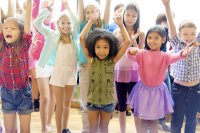Research-Tested Benefits of Breaks
Students are easily distracted, but regular, short breaks can help them focus, increase their productivity, and reduce their stress.
Regular breaks throughout the school day—from short brain breaks in the classroom to the longer break of recess—are not simply downtime for students. Such breaks increase their productivity and provide them with opportunities to develop creativity and social skills.
Students, particularly young ones, often struggle with staying focused for long periods of time. In a 2016 study, psychologist Karrie Godwin and a team of researchers measured how attentive elementary students were during class, and discovered that they spent over a quarter of the time distracted, unable to focus on the teacher or the current task. Shorter lessons, however, kept student attention high: Teachers found it more effective to give several 10-minute lessons instead of fewer 30-minute ones.
And there are more benefits to downtime than increased attention: It decreases stress, increases productivity, boosts brain function, and provides opportunities for children to learn social skills.
Reducing Stress, Increasing Productivity
Recent research shows that our brains aren’t idle when we take breaks—they’re hard at work processing memories and helping us make sense of what we experience. In a groundbreaking 2012 study, Mary Helen Immordino-Yang and her colleagues at USC and MIT used an fMRI scanner to examine neural activity during the brain’s “default mode”—a state of rest that’s usually associated with taking a break or letting our minds wander. In this state, the brain is still highly active, with a different set of regions lighting up than when we’re focused on the outside world.
Further experiments showed that this default mode is crucial for consolidating memories, reflecting on past experiences, and planning for the future—in other words, it helps shape how we make sense of our lives. Breaks keep our brains healthy and play a key role in cognitive abilities such as reading comprehension and divergent thinking (the ability to generate and make sense of novel ideas). “Rest is indeed not idleness, nor is it a wasted opportunity for productivity,” Immordino-Yang and her colleagues write.
So breaks are an essential part of learning. But the benefits extend beyond the psychological well-being of students. Particularly for younger students, regular breaks throughout the school day can be an effective way to reduce disruptive behavior. In a series of recent studies, short physical activity breaks in the classroom improved students’ behavior, increasing the effort they put into their activities as well as their ability to stay on task.
Both students and teachers benefit from using unstructured breaks to reduce stress. According to the American Psychological Association, stress can have serious health consequences, increasing someone’s chances of serious conditions such as heart disease and depression. The APA recommends frequent breaks, in addition to other activities such as exercise and mediation.
Boosting Brain Function
Exercise breaks—whether short activities in the classroom or recess—help promote physical fitness, which in turn boosts brain health. In 2013, the National Academy of Medicine (then called the Institute of Medicine) published a major report on the benefits of physical activity on children’s cognitive development and academic success.
At the time, less than half of U.S. students were meeting the federal guideline of 60 minutes of daily exercise. Bringing together experts across a range of fields, the report made the case for why regular exercise crucially belongs in schools: It not only provides physical health benefits to students but also enhances their cognitive functioning, leading to higher academic performance.
How does exercise improve learning? Engaging in physical activity increases blood flow and oxygenation in the brain, boosting neural connectivity and stimulating nerve cell growth in the hippocampus, the center of learning and memory. So exercise actually changes the structure of our brains, with a number of benefits: improved attention and memory, increased brain activity and cognitive function, and enhanced mood and ability to cope with stress.
Decades of research show that physically active children consistently outperform their inactive peers academically on both a short- and long-term basis.
Developing Social Skills
Longer breaks—such as recess or playtime—provide opportunities for children to learn important life skills. Research shows that when children play together, they learn how to take turns, resolve conflicts, and solve problems. They also learn how to manage their own emotions and behavior—fundamental skills for life. So dropping recess is a mistake, according to the American Academy of Pediatrics: Recess is a “crucial and necessary component of a child’s development,” and sacrificing it for more academics is counterproductive.
Unstructured playtime provides an opportunity for imaginary and creative play and allows children to practice divergent thinking. They benefit from the freedom to explore new ideas without fear of failure or the stress of grades, and regular exposure to new experiences can also increase their cognitive flexibility, preparing them for academic challenges.
Incorporating Breaks in Your Classroom
Several breaks throughout the day can help students stay focused:
- If students are getting rowdy or bored, a few moments of exercise in the classroom can reset their attention.
- Use brain breaks—short activities that stimulate curiosity—to boost students’ motivation and improve their mood.
- Set aside time during class for creativity—makerspaces, Genius Hour, and art projects can help boost kids’ imaginations.
While breaks can help reset student focus, a useful alternative—especially for older students—is to switch teaching strategies throughout a lesson: Try having students team up on a think-pair-share activity or work in groups, spend a few minutes reviewing concepts, or give a low-stakes practice test at the end of a lesson. These activities can help break up the monotony of a long lesson, and as a bonus, boost students’ memory.
